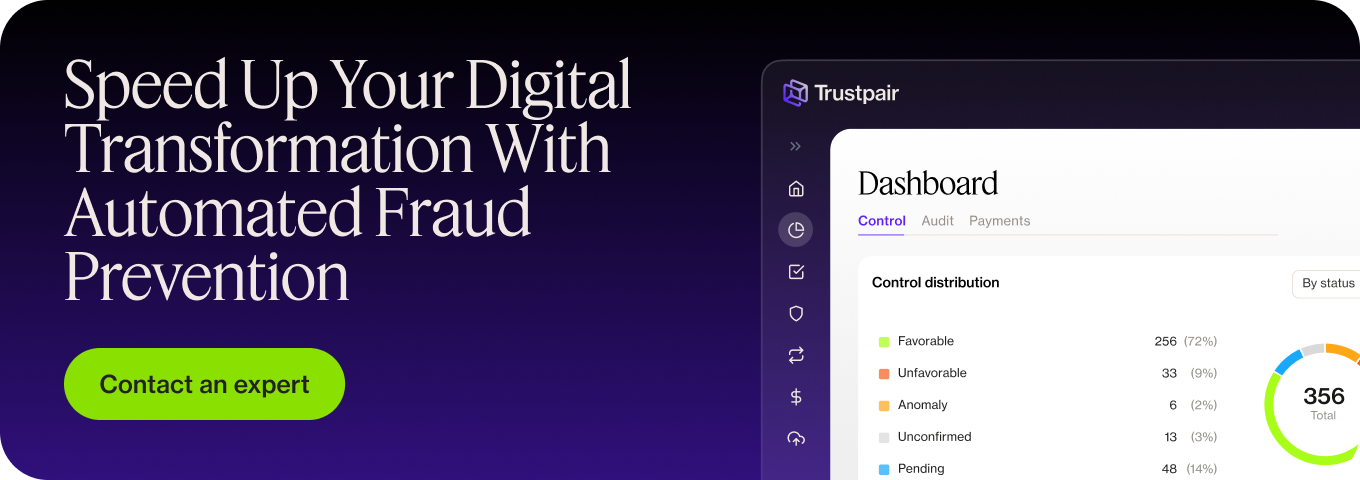IFRS 17 is the new global accounting standard for insurance contracts, designed to provide consistent, transparent, and comparable financial reporting. It replaces IFRS 4, which allowed insurers to use a wide range of local accounting practices, often making results hard to compare.
IFRS 17 requires insurers to rely on detailed, accurate, and standardized financial data, and Trustpair can help finance teams achieve the same standard of reliability through clean vendor data. For insurers, this means system upgrades, process changes, and potentially revised product strategies for good governance and compliance.
IFRS 17 for insurers: Key Takeaways
- IFRS 17 provides a standardised rulebook to help insurers to accurately report their financial performance
- IFRS 17 came in after the previous guidelines (IFRS 4) were too flexible, making transparency and comparison difficult
- Insurers must comply with IFRS 17
- The requirements focus on the use and presentation of certain data categories, standardising the measurement period and types of profit calculations
What is IFRS 17 in simple terms?
IFRS 17 is an international standard introduced to help insurers’ financial reporting to become consistent, and therefore easily comparable, between different regions. It asks that every insurer measures its liabilities, profits and assets in the same way, which gives a more transparent insight into the insurer’s position and financial health.
Before IFRS 17, each company could choose to report its finances in its own way, which led to variance in what metrics were reported and when. Metrics ranged from insurance acquisition cash flows to insurance service expenses, reinsurance contracts held and discretionary participation features. This history created difficulties in understanding a company’s position, but it all changed in January 2023 when IFRS 17 was mandated.
The International Accounting Standards Board is the team behind the IFRS, and mandates annual reporting periods of at least one year. It gives a better understanding of the company’s financial position and requires comprehensive income, financial statements and significant insurance risk reporting. The subsequent measurement can be compared between providers for fairer and more transparent industry practices.
Who needs to comply with IFRS 17?
Since 2023 onwards, three types of entities have had to comply with the implementation of IFRS 17:
- Insurance companies: all types of insurance, including wholesale, life and mutual insurers
- Non-insurance entities: although outside of the traditional insurance sector, if these companies issue contracts that meet the criteria, they must also comply
- Public sector organizations: those performing accounting services for insurance clients must also comply
What are the main requirements of IFRS 17?
Firstly, insurers must decide which of their contracts come under the scope of IFRS 17. Those with insurance contract services and underlying items are then required to perform:
- Measurement of insurance contracts: Insurers must measure contracts using current estimates of future cash flows and other comprehensive income metrics. A risk adjustment is required to reflect the uncertainty in those cash flows. The “Contractual Service Margin (CSM)” must be recognized to compensate and spread unearned profit across the period services are provided.
- Recognition of revenue and profit: Insurance revenue is recognized as from the effective date that services are delivered, not when premiums are received. Profits are released systematically over the coverage period, ensuring they align with the insurer’s performance.
- Presentation and disclosure: Insurers must present insurance revenue separately from investment income, providing a clearer picture of performance. Enhanced disclosures are required, including reconciliations, assumptions, and risk exposures, to improve comparability across companies. Finance automation can be really useful to implement here.
- Grouping of contracts: Contracts must be grouped by portfolio and then into cohorts of contracts issued no more than one year apart. Within each group, contracts are classified as:
- Onerous (loss-making)
- No significant possibility of becoming onerous
- Other remaining contracts
- Discounting: Future cash flows must be discounted using current, market-consistent discount rates, reflecting both the time value of money and characteristics of the liabilities.
- Transition requirements: On adoption, insurers must apply IFRS 17 retrospectively where possible, or use modified or fair value approaches when full data isn’t available.
How does IFRS 17 differ from IFRS 4?
IFRS 17 requirements are largely based on the older IFRS 4 requirements – with some key updates. Generally, the amendments provide benefits, both to the investors and insurers themselves.
Here are the main differences for the insurance industry:
| IFRS 17 | IFRS 4 |
|---|---|
| Companies must measure insurance contracts at current value, improving their financial data management with annual reporting periods. | Companies may measure insurance contracts using out-of-date information, increasing financial risk. |
| Companies will reflect the time value of money in estimated payments to settle incurred claims. | Companies may not consider the time value of money when measuring liabilities for claims. |
| Companies must measure their insurance contracts based only on the obligations that the entity recognises are created by these contracts. | Some companies measure insurance contracts based on the value of their investment portfolios, rather than investment components. |
| Companies should not rely on non-GAAP measures; supplementary information will enable more meaningful comparisons. | Many companies provide alternative performance measures (i.e. non-GAAP measures) to supplement IFRS 4 information, creating confusion and making comparison more difficult. |
How can insurers ensure compliance with IFRS 17?
Preparing for IFRS 17 goes beyond an accounting exercise; it requires changes to systems, processes, and even how insurers think about profitability.
1. Data systems
First, insurers need to invest in robust data and systems to understand the full extent of their investment contracts. IFRS 17 requires detailed, granular information on cash flows, risks, and profitability across groups of contracts. Many legacy systems were not designed to handle this level of detail, so insurers must upgrade or integrate new platforms to capture, process, and report the required data.
2. Align functions
Companies should ensure their finance and actuarial functions align and collaborate more closely. Unlike IFRS 4, which often treated the two separately, IFRS 17 requires continuous collaboration. Actuarial models feed directly into financial reporting, so teams need to establish consistent methodologies, assumptions, and controls.
3. Review product and portfolio strategies
Since IFRS 17 requires grouping contracts and assessing onerous contracts, some products may appear less profitable under the new lens. Insurers might have to reconsider pricing, product design, or portfolio mix to optimize performance.
4. Training team members
With the changes in mind, it’s important that team members understand the principles of IFRS 17 and not just the outcomes. Decision-makers should also build these requirements and rules into their strategies.
5. Communications
With the change in how contracts are measured, classified and presented, analysts will need to consider how results are explained to investors and stakeholders. Since many of the new standards may actually decrease the financial outlook, this is important in maintaining trust and setting expectations with the information provided.
A recap on IFRS 17
IFRS 17 is the global accounting standard for insurance contracts, designed for better transparency and comparison. It changes how insurers measure contracts, ensuring statements better reflect the economics of the business. While compliance requires effort, IFRS 17 ultimately helps stakeholders gain a clearer view of performance and risk.



